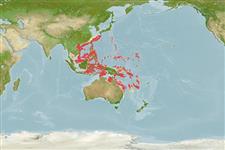Common names from other countries
Environment: milieu / climate zone / depth range / distribution range
Écologie
marin bathydémersal; profondeur 80 - 385 m (Ref. 116586), usually 80 - 380 m (Ref. 116586). Deep-water; 30°N - 35°S, 34°E - 169°E (Ref. 57285)
Western Pacific: in low latitude tropics; common in the Philippines, Vietnam, eastern Indonesia and off the southern coasts of Japan and Taiwan.
Taille / Poids / Âge
Maturity: Lm ? range ? - ? cm
Max length : 13.0 cm TL mâle / non sexé; (Ref. 2202)
Description synthétique
Clés d'identification | Morphologie | Morphométrie
Épines dorsales (Total) : 9; Rayons mous dorsaux (Total) : 9; Épines anales: 2; Rayons mous anaux: 7; Vertèbres: 25. Resembles S. japonicus and S. analis but distinguished by the following characters: pelvic spine with distinct serration on the anterior edge; 2 spines and 7 soft rays in anal fin; 16 rays in pectoral fin; and small body size (less than 10 cm). Body blackish -brown dorsally, paler ventrally.
Occurs in the continental shelf and slope (Ref. 7300).
Life cycle and mating behavior
Maturities | Reproduction | Spawnings | Egg(s) | Fecundities | Larves
Schwarzhans, W.W. and A.M. Prokofiev, 2017. Reappraisal of Synagrops, Günther, 1887 with rehabilitation and revision of Parascombrops Alcock, 1889 including description of seven new species and two new genera (Perciformes: Acropomatidae). Zootaxa 4260(1):1-74. (Ref. 116586)
Statut dans la liste rouge de l'IUCN (Ref. 130435)
CITES (Ref. 128078)
Not Evaluated
Menace pour l'homme
Harmless
Utilisations par l'homme
Outils
Articles particuliers
Télécharger en XML
Sources Internet
Estimates based on models
Preferred temperature (Ref.
115969): 13.3 - 22.1, mean 15.8 (based on 28 cells).
Phylogenetic diversity index (Ref.
82804): PD
50 = 0.5001 [Uniqueness, from 0.5 = low to 2.0 = high].
Bayesian length-weight: a=0.00955 (0.00424 - 0.02152), b=3.02 (2.82 - 3.22), in cm Total Length, based on LWR estimates for this (Sub)family-body shape (Ref.
93245).
Niveau trophique (Ref.
69278): 3.5 ±0.5 se; based on size and trophs of closest relatives
Résilience (Ref.
120179): Milieu, temps minimum de doublement de population : 1,4 à 4,4 années (Assuming tmax>3).
Fishing Vulnerability (Ref.
59153): Low vulnerability (10 of 100).
